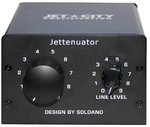Devin":32cvamj7 said:
stephen sawall":32cvamj7 said:
The THD is analog, reactive load
If you're talking about the THD Hotplate it is a resistive load.
stratjacket":32cvamj7 said:
Suhr Reactive Load or just about any reactive load. I would not recommend any resistive type such as a Hot Plate.
"We keep getting asked if the Hot Plate attenuator is resistive or reactive.
There is a lot of misinformation floating out there, including a recent "article" on Reverb claiming that the THD Hot Plate is a resistive attenuator. I both phoned and sent emails to correct the writer of the article, but never got a call or email in return.
People seem to assume that reactive attenuators are something new, which they are not. We’ve been building them since 1994. Many assume that since the Hot Plate has been around for so long, it must be a resistive unit like the Scholz Power Soak and the Altair PW-5. (For the trivia minded, the PW stood for "power waster".)
The Hot Plate is fully reactive in three different “modes", as opposed to one mode like all the other attenuators claiming to be reactive. The bright, deep and light bulb switches let you select exactly how reactive it is, and in which frequency ranges and dynamic ranges the reactance is most prevalent, but no matter how you set it, it is always reactive in all attenuation modes and in the “Load” setting as well. It’s the only attenuator which does this.
Some attenuators like the Marshall Power Brake (no longer produced) use transformers instead of networks of resistors, capacitors and inductors, to do the dropping. The problem with this entire approach is that the only way that a transformer can reduce the power getting to the speaker is by creating an impedance mismatch, which is never good for the amp, nor does it ever sound or “feel” particularly good. With a Hot Plate, if you have an 8 ohm amp, an 8 ohm Hot Plate and an 8 ohm speaker, no matter how you set it, the amp is always “seeing” an 8 ohm load. It is the only attenuator that does this, which is why there are 5 versions. In each version, every single capacitor, resistor and inductor is optimized for that impedance.
Another aspect of this discussion that is worth mentioning is that the absolute safest load for any amplifier is one that is 100% resistive with no reactive element at all. The problem with a purely resistive load is that they don’t sound very good at all. Guitar players are used to the hearing the amp as it responds to the inductance of the speaker’s voice coils, the motion of the cones (causing a huge momentary change in the load), and often the effect of the compression of the air in the cabinet on the cone/voice coil motion, and thus on the load. So, more reactance is not necessarily a good thing, especially when it goes beyond mimicking the reactance of a speaker cabinet.
Over the past 26 years, we’ve sold more than 100,000 Hot Plates, making it the best-selling attenuator ever built. It’s also the only attenuator made that is recommended by other manufacturers. The Weber is recommended only by Weber. The Rivera is recommended only by Rivera. The THD Hot Plate is recommended my Marshall, Fender, HiWatt, Soldano, Bogner, Diezel, MESA/Boogie, and dozens of other amp companies. And, over 30 years, we’ve only ever had two people come forward, claiming that their amps were damaged by a Hot Plate. One was using a 4-ohm Hot Plate on a Marshall set to 16 ohms, which caused the output transformer to fail, just as it would have if he had run into a 4 ohm cabinet. The other had just had the output transformer in his Vox AC30 replaced when he started using a Hot Plate on his amp with the new transformer. He claimed that the Hot Plate had blown his new transformer. We paid to have the amp sent to us for investigation. It turned out that his "tech" had replaced his 30-watt AC30 output transformer with a 15-watt Fender Tweed Deluxe output transformer, which could not possibly take the output from a quad of EL84 tubes and was less than 1/4 the size of the original output transformer.
We hope this helps to dispel some of these myths."
THD / Andy Marshall Design


